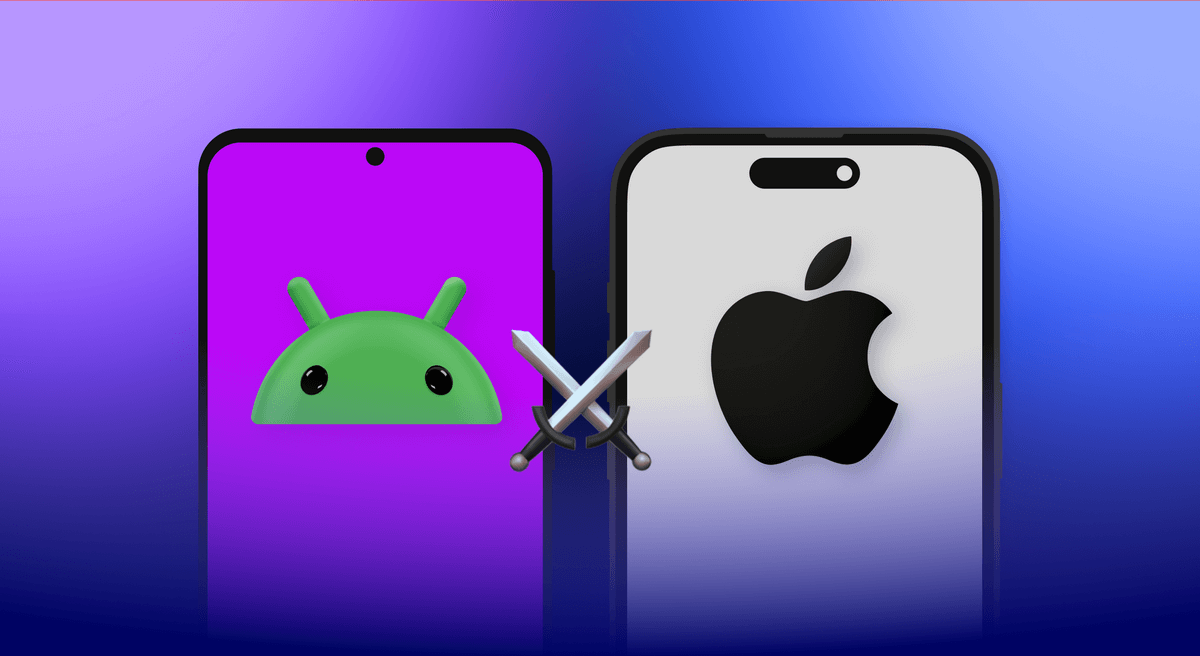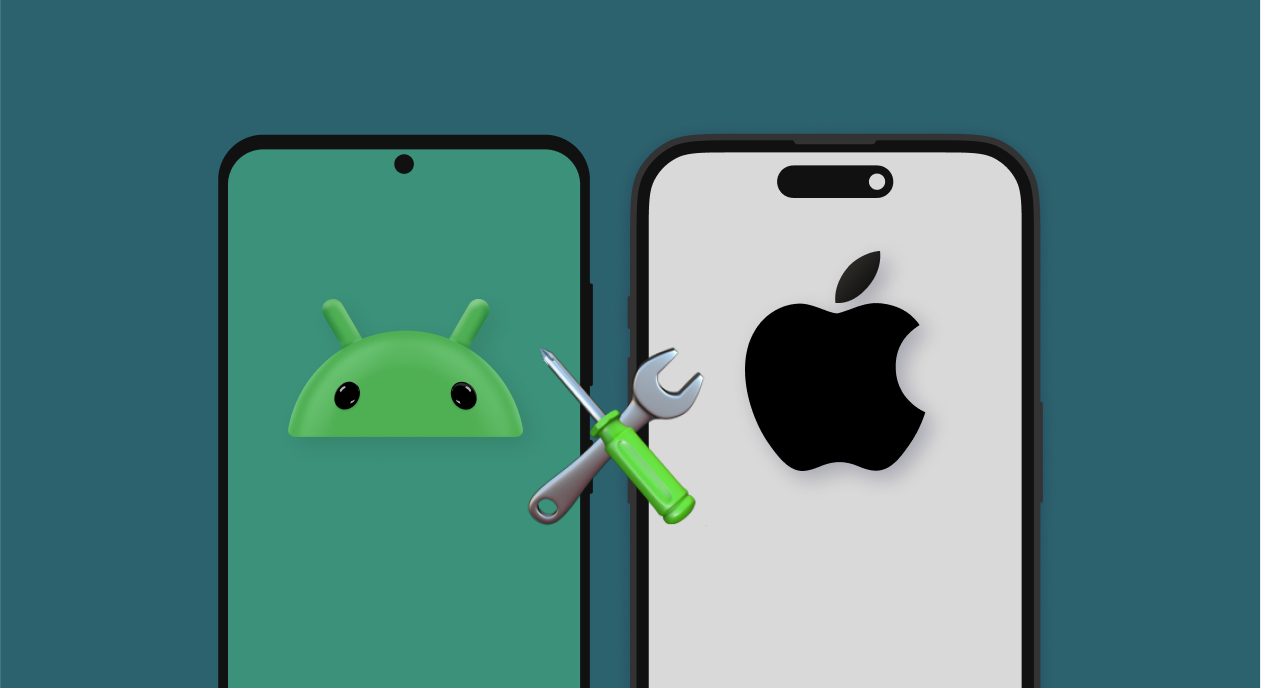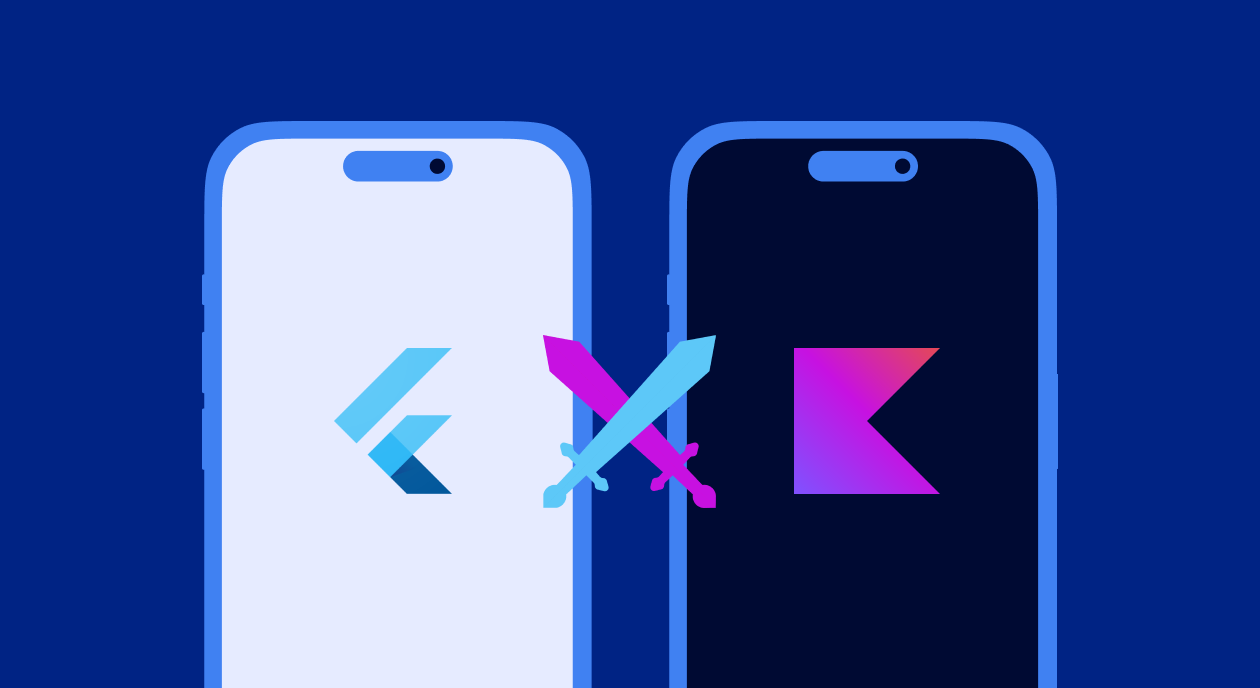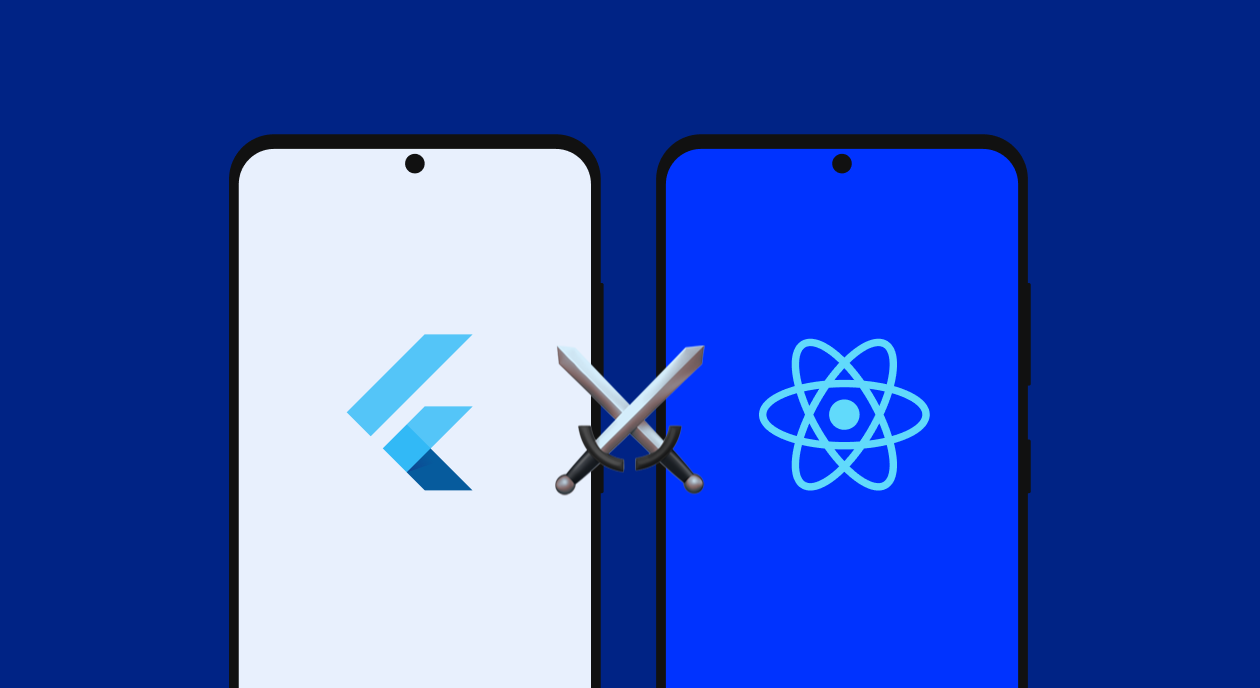Choosing the right mobile app store to launch — or, rather said, to “first” launch — your mobile app can make a big difference to your app’s long-term economics. And while eventually, you might find yourself releasing your app in both the App Store and Google Play, you may want to (like so many app developers) start with just an iOS app.
In fact, you might also stick to the App Store alone. Or to Google Play. Why? Because while Apple’s App Store and Google Play cater to the same smartphone audience, their user bases differ in their app journeys. And the differences are real, as we’ll see in today’s article. So let’s see how iPhone users compare with Android users and how these audiences’ preferences can impact your app business. We’ll discuss:
- An overview of the market share of the App Store and Google Play
- The similarities and differences between iOS and Android users and how each type engages with mobile apps
- Key considerations when choosing a platform for distributing a mobile app
Here goes.
An overview of each platform’s market share: Android vs. iOS
When it comes to mobile operating systems, Android has consistently been a leader, dominating the market with about a 70% market share. iOS comes in second at about 28%. So, most smartphone users across the globe are Android users. This is mostly because Android phones are more affordable. You can get an entry-level Android smartphone for a very decent price. iOS, on the other hand, feels steep for a large user population. This socioeconomic divide is one of the most important differences between Android and iOS users. iOS users pay a premium for a good mobile experience, and as you’ll see, this reflects in their app spending behavior as well. All that said, this “fundamental” divide may be blurring now with the surge of high-end Android phones.
Also, while Android has more users, the distribution varies greatly regionally. For instance, in the U.S., Apple’s iOS is the leading player, with Google coming in second with a 45.8% market share. On the other hand, for North America, Android has the edge with a 53.9% market share, with iOS coming in second at 45.6. Android also leads the market share in Europe, but with a much higher market share (65%). In contrast, Android dominates the mobile market in Asia with a 77% market share, whereas iOS accounts for just 21%. If you zoom in at the country level, the iOS vs. Android market share can look even more different. For example, Android is a clear winner in India, a significant smartphone market, with iOS having just a 3.55% market share.
As a developer, you need to know what percentage of users you could reach with your app. For instance, if you’re launching an iOS app, you’re likely reaching more users in the U.S., but only a small percentage in Asia and an even smaller segment in India. You get the drift.
Key demographics of each user base: iPhone vs. Android users
The majority of iPhone app users belong to younger age groups. In the U.S. (as of June 2023), 65% of the respondents in the 18-to-29 age group in a survey said they used an iPhone. Also, thanks to Gen Z’s adoption, iPhone’s market share may grow 7% every year, according to a Bloomberg report. Likewise, in the U.K., 73% of the respondents belonging to the very Gen Z age group (18-to-19-year-olds) used iPhones. In India, though, about half of iPhone users (44.7%) belong to the 25-to-34 age group.
On the other hand, Android adopters in the U.S. belong primarily to the 35+ age group. In general, Android users tend to be older. India, though, has its Android user base evenly distributed across a few different age groups (35-to-44 years: 18.9%; 25-to-34 years: 51.2%; 18-to-24 years: 25.8%).
As you can tell, user population distribution can be diverse across different regions. Taking it into account is crucial for connecting with your right user base. So if you’ve an app targeting a particular age group, a budgeting app for Gen Z, for instance, you want your app to be in the App Store.
As far as gender distribution goes, the iPhone user base is fairly even, with roughly 51% of users being women and 49% being men. However, Android appears to have a more male-dominated user population, with 57% being male.
Income-wise, iPhone users appear to earn more. Back in 2014, Comcast research found the median iPhone user to earn $85,000 annually, 40% higher than the median Android phone user, who was found to make $61,000 a year. A more recent survey by Slickdeals (2018) discovered that iPhone users earn an average annual pay of $53,251, with Android users making $37,040 annually on average.
Although these trends don’t hold globally for the entire user populations the two mobile operating systems cater to, they do give insight into why Android users are seen to be more frugal when it comes to app spending.
How iPhone and Android users engage with apps
App preferences: Do iPhone and Android look for the same kind of apps in both the app stores?
When it comes to popular app categories, users across both the app stores are almost equally and highly interested in gaming, business, and education apps. These are the three most popular app categories across the App Store and Google Play.
However, beyond these three, different categories perform differently for each user base. For example, lifestyle apps are almost twice as popular with iOS users as Android users (7.93% vs. 4.53%). Likewise, the health and fitness category is more popular with the iOS user base than with Android users (5.08% vs. 3.87%). Finance apps, too, generate more interest in iOS users than with Android ones (4.16% vs. 3.35%).
Subcategories can perform differently, too. For instance, while the App Store is the more popular platform for meditation apps, the Android platform is expected to generate more downloads and revenue with them.When it comes to conversion rates, both audiences, again, act differently. Conversion rates don’t just vary greatly across both the app stores across different categories but also regionally. For instance, the average conversion rate for the productivity category in Google Play is 36.3%, while the same for the App Store is a staggering 65.8%:
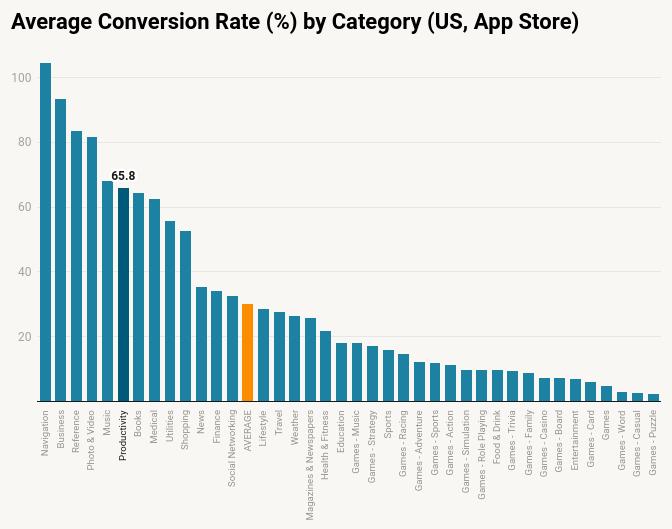
App spending behavior: Who spends more on mobile apps? iPhone vs. Android users
When it comes to app spending, iOS users spend significantly more than Android users. In fact, in 2027, iOS users are expected to spend about $125 billion on apps. Android users, in contrast, will spend only about half of that sum (60 billion):
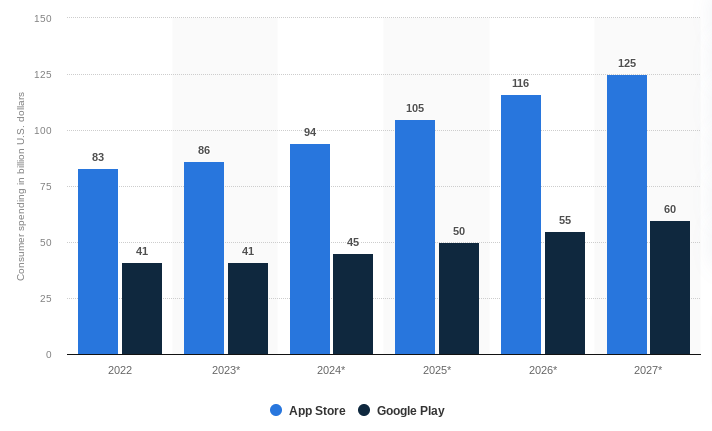
Another thing to note here is the growth trend across the platforms. As you can see above, iOS users’ app spending is growing consistently each year and is considerably higher than that of Android users. Visibly, Android users gravitate more toward free or freemium apps. Also, when it comes to in-app purchases, iOS users spend billions more than Android users on mobile app subscriptions:
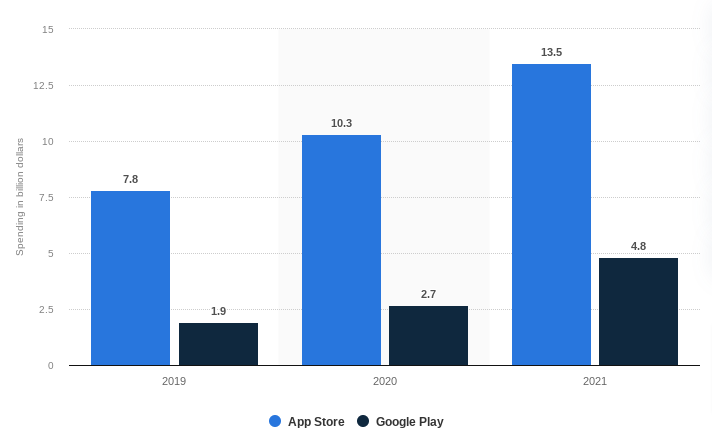
And while both the app stores comprise mostly free apps — 94.95% of apps on the App Store and 96.95% of apps on Google Play are free — the Apple App Store still has more paid apps than Google.
App retention: Who’s more loyal? iPhone or Android users?
When it comes to app retention, iOS users seem to be more loyal than Android users. The average (Day 30) app retention rate for iOS users is about 4.13%, considerably higher than the average (Day 30) retention rate for Android users (at about 2.59%).
In fact, iOS users engage with apps much more than Android users. This reflects in the retention rates across all the key periods, including the Day 30 retention rate:
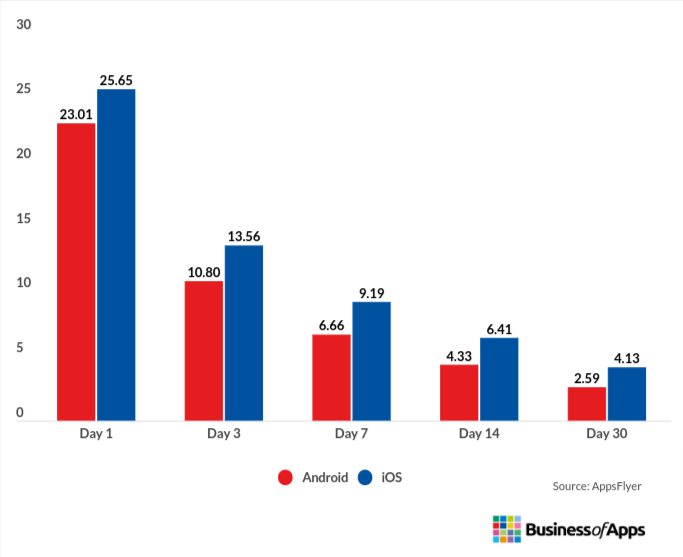
Android’s retention rates also seem to have steadily declined over the last three years:
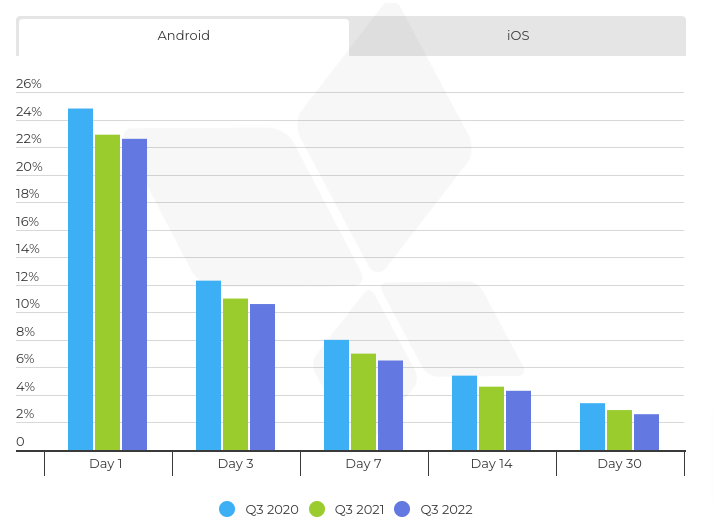
So even if you have to spend more money acquiring an iOs user, you could be looking at a much higher lifetime value.
How to choose a platform for your mobile app
In addition to factoring in how iOS and Android user bases compare, here are some more considerations when selecting a platform to distribute your app.
The technicalities
Sometimes, Android may be a better option because of the kind of app you want to build. That’s because it’s considered a more “open” system than Apple’s iOs. At other times, developing an Android app can involve a lot of work, given that so many companies ship Android in all kinds of devices — there are even flip phones to consider. With iOS, on the other hand, you can only have as many devices as Apple makes. You get the idea.
In his response to an Android vs. iOS query (from a few years ago), iOS mobile developer Trausti Thor Johannsson succinctly explains why developers had a headstart with iOS instead of Android. He shares: “You have a Mac, you download Xcode, that’s it. You hook your phone to your computer, you click yes that you want the device to be a developer device. And you are off. You just develop your app. The simulator starts in less than 3 seconds, it emulates all devices. You can easily rotate and pinch and zoom. You get the whole package. All the libraries you need come from Apple, and there are endless open source ones. Well over 90–95% of all users use the latest operating system in a few weeks. You have a design pattern to follow, and everyone pretty much follows it. You have an empty working application up and running in a matter of minutes.” With Android, on the other hand, you’re dealing with too many devices from too many companies running too many versions.
In general, Android apps also take more development bandwidth — they take more lines of code and take longer to ship.
Your monetization model
Choosing the right app store to launch your mobile app mainly comes down to analyzing which store’s audience would be more willing to do what you need them to do. For instance, if you’re using the in-app ads monetization method, you’d want more users to download your app. Launching a free app in Google Play could work well here. Alternatively, if you’re going to monetize via in-app purchases like subscriptions, you might want to consider launching your app on the App Store, as iOS users tend to pay more for app subscriptions.
User acquisition costs
Another factor to consider when choosing an app store for your app is the cost of acquiring users. A Statista report (2018–2019) on the acquisition cost across the app stores found different costs associated with in-store actions like app downloads, installs, and purchases.
In general, the cost of acquisition (in terms of app installs) on the App Store is higher than that on Google Play.
So, if you’re trying to get more app installs (a good strategy when you’re using ads for monetizing your app), Android is a better platform for you as an app install costs $1.22 on Google Play compared to $3.6 on the App Store:
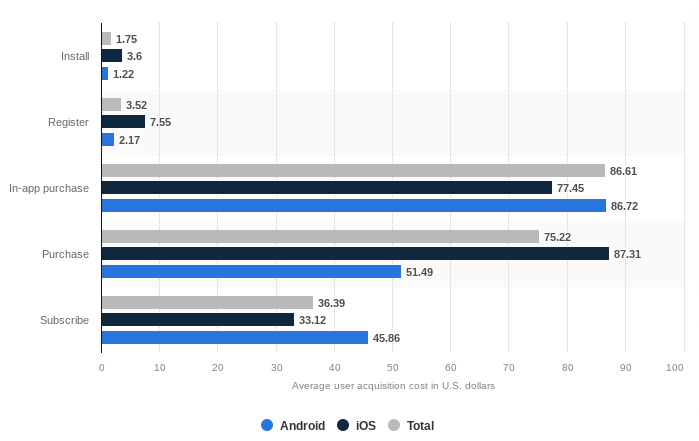
In general, most app developers that are clear about using in-app purchases as their monetization model start with iOS, as iOS users tend to spend much more on apps as compared to Android users.
Wrapping it up…
As you just saw, Android and iOS users have considerable differences in all stages of their mobile app journey, from their app preferences to their post-purchase behavior. And all these factors impact your app’s monetization potential, making it essential to study them before you choose a distributor for your app.
If you want to launch a lifestyle app, thinking that you’re reaching the same audience irrespective of the app store you launch your app in might be a mistake. With Google Play, you’re likely reaching an audience that might be (primarily) looking for a fully functional free or freemium app. With the App Store, in contrast, you’re looking at an audience that’s open to paying for it or even subscribing.
Also, even when you choose the right app store to launch your app, finding pricing that works well for your target user population (and its different segments) can be tricky. Experimenting with different products, price points, and offers is the only way to determine what works best. Explore Adapty to see how you can add such experimentation to your mobile app business mix.
Adapty comes with SDKs for both Android and iOS that let you test different paywalls – pretty much everything that lives on paywalls (from your paywall’s messaging, graphics, and layout to its products, pricing, and offers). You can also show different paywalls to your different user segments. Paywall personalization is possible, too. We also support all the leading cross-platform mobile app development frameworks, so if you’ve a Flutter- or React Native-based app, Adapty can still help you. Check out Adapty.
